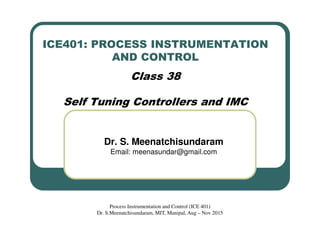
Self-Tuning Controllers & IMC for Process Instrumentation
- 1. ICE401: PROCESS INSTRUMENTATION AND CONTROL Class 38 Self Tuning Controllers and IMC Dr. S. Meenatchisundaram Email: meenasundar@gmail.com Process Instrumentation and Control (ICE 401) Dr. S.Meenatchisundaram, MIT, Manipal, Aug – Nov 2015
- 2. Adaptive Control Systems: Process Instrumentation and Control (ICE 401) Dr. S.Meenatchisundaram, MIT, Manipal, Aug – Nov 2015 • An adaptive control system is one in which the controller parameters are adjusted automatically to compensate for changing process conditions. • Many adaptive control techniques have been proposed for situations where the process changes are largely unknown or unpredictable, as contrasted with situations amenable to the gain- scheduling approach. • Many such controllers are referred to as self-tuning controllers or self-adaptive controllers.
- 3. Self Tuning Controllers: Process Instrumentation and Control (ICE 401) Dr. S.Meenatchisundaram, MIT, Manipal, Aug – Nov 2015 • In self-tuning control, the parameters in the process model are updated as new data are acquired (using on-line estimation methods), and the control calculations are based on the updated model. • For example, the controller settings could be expressed as a function of the model parameters and the estimates of these parameters updated on-line as process input/output data are received. • Self-tuning controllers generally are implemented as shown in Fig.
- 4. Self Tuning Controllers : Process Instrumentation and Control (ICE 401) Dr. S.Meenatchisundaram, MIT, Manipal, Aug – Nov 2015
- 5. Self Tuning Controllers: Process Instrumentation and Control (ICE 401) Dr. S.Meenatchisundaram, MIT, Manipal, Aug – Nov 2015 • In Fig., three sets of computations are employed: estimation of the model parameters, calculation of the controller settings, and implementation of the controller output in a feedback loop. • Most real-time parameter estimation techniques require that an external forcing signal occasionally be introduced to allow accurate estimation of model parameters. • Such a perturbation signal can be deliberately introduced through the set point or added to the controller output. • During each disturbance or set-point change, the process response is compared to the predicted model response, and then the model can be updated based on the prediction error.
- 6. Internal model control (IMC): Process Instrumentation and Control (ICE 401) Dr. S.Meenatchisundaram, MIT, Manipal, Aug – Nov 2015 • Internal model control (IMC), which is based on an accurate model of the process, leads to the design of a control system that is stable and robust. • A robust control system is one that maintains satisfactory control in spite of changes in the dynamics of the process. • In applying the IMC method of control system design, the following information must be specified: • Process model • Model uncertainty • Type of input (step, ramp, etc.) • Performance objective (integral square error, overshoot, etc.)
- 7. Internal Model Control Structure: Process Instrumentation and Control (ICE 401) Dr. S.Meenatchisundaram, MIT, Manipal, Aug – Nov 2015
- 8. Internal Model Control Structure: Process Instrumentation and Control (ICE 401) Dr. S.Meenatchisundaram, MIT, Manipal, Aug – Nov 2015
- 9. Internal Model Control Structure: Process Instrumentation and Control (ICE 401) Dr. S.Meenatchisundaram, MIT, Manipal, Aug – Nov 2015 • If the model exactly matches the process (i.e., Gm=G ), the only signal entering comparator 1 in Fig. is U1. (The signals from G and Gm are equal and cancel each other in going through comparator 2). • Since U1 is not the result of any processing by the transfer functions in the forward loop, U1 is not a feedback signal but an independent signal that is equivalent to R in its effect on the output C. • In fact, there is no feedback when G = Gm, and we have an open-loop system as shown in Fig. • In this case the stability of the control system depends only on GI and Gm. If GI and Gm are stable, the control system is stable.
- 10. Internal Model Control Structure: Process Instrumentation and Control (ICE 401) Dr. S.Meenatchisundaram, MIT, Manipal, Aug – Nov 2015 • Ideally, we should like to have C track R without lag when only a set point change occurs (i.e., U1 =0). • For this to occur, we see from previous Fig. or Eq. that G1 G = 1, or since G = Gm, we may write GIGm = 1. Solving for GI gives • The above equation simply states that the IMC controller should be the inverse of the transfer function of the process model.
- 11. Internal Model Control Structure: Process Instrumentation and Control (ICE 401) Dr. S.Meenatchisundaram, MIT, Manipal, Aug – Nov 2015 • IMC Design Procedure • IMC Design Example • Refer Page No. 381, Process Systems and Analysis by Donald R Coughanowr, Third Edition.
- 12. References: • http://www.enggcyclopedia.com/2012/06/split-range-control-loop/ • http://www.controleng.com/single-article/a-dual-split-range-control- strategy-for-pressure-and-flow- processes/e02afa4eb60717657598546e8feb895e.html Process Instrumentation and Control (ICE 401) Dr. S.Meenatchisundaram, MIT, Manipal, Aug – Nov 2015
